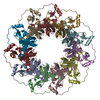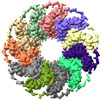+ Open data
Open data
- Basic information
Basic information
| Entry |  | |||||||||
|---|---|---|---|---|---|---|---|---|---|---|
| Title | Cryo-EM structure of human full-length RAD52 | |||||||||
 Map data Map data | Sharpened map used for modeling | |||||||||
 Sample Sample |
| |||||||||
 Keywords Keywords | DNA repair / RECOMBINATION | |||||||||
| Function / homology |  Function and homology information Function and homology informationdouble-strand break repair via single-strand annealing / DNA double-strand break processing involved in repair via single-strand annealing / DNA recombinase assembly / mitotic recombination / HDR through MMEJ (alt-NHEJ) / regulation of nucleotide-excision repair / HDR through Single Strand Annealing (SSA) / SUMOylation of DNA damage response and repair proteins / protein-DNA complex / double-strand break repair via homologous recombination ...double-strand break repair via single-strand annealing / DNA double-strand break processing involved in repair via single-strand annealing / DNA recombinase assembly / mitotic recombination / HDR through MMEJ (alt-NHEJ) / regulation of nucleotide-excision repair / HDR through Single Strand Annealing (SSA) / SUMOylation of DNA damage response and repair proteins / protein-DNA complex / double-strand break repair via homologous recombination / double-strand break repair / single-stranded DNA binding / cellular response to oxidative stress / DNA recombination / protein-containing complex / DNA binding / nucleoplasm / identical protein binding / nucleus Similarity search - Function | |||||||||
| Biological species |  Homo sapiens (human) Homo sapiens (human) | |||||||||
| Method | single particle reconstruction / cryo EM / Resolution: 2.5 Å | |||||||||
 Authors Authors | Schnicker NJ / Razzaghi M / Spies M | |||||||||
| Funding support |  United States, 2 items United States, 2 items
| |||||||||
 Citation Citation |  Journal: Nature / Year: 2025 Journal: Nature / Year: 2025Title: The RAD52 double-ring remodels replication forks restricting fork reversal. Authors: Masayoshi Honda / Mortezaali Razzaghi / Paras Gaur / Eva Malacaria / Giorgia Marozzi / Ludovica Di Biagi / Francesca Antonella Aiello / Emeleeta A Paintsil / Andrew J Stanfield / Bailey J ...Authors: Masayoshi Honda / Mortezaali Razzaghi / Paras Gaur / Eva Malacaria / Giorgia Marozzi / Ludovica Di Biagi / Francesca Antonella Aiello / Emeleeta A Paintsil / Andrew J Stanfield / Bailey J Deppe / Lokesh Gakhar / Nicholas J Schnicker / M Ashley Spies / Pietro Pichierri / Maria Spies /   Abstract: Human RAD52 is a multifunctional DNA repair protein involved in several cellular events that support genome stability, including protection of stalled DNA replication forks from excessive degradation. ...Human RAD52 is a multifunctional DNA repair protein involved in several cellular events that support genome stability, including protection of stalled DNA replication forks from excessive degradation. In its gatekeeper role, RAD52 binds to and stabilizes stalled replication forks during replication stress, protecting them from reversal by SMARCAL1 motor. The structural and molecular mechanism of the RAD52-mediated fork protection remains elusive. Here, using P1 nuclease sensitivity, biochemical and single-molecule analyses, we show that RAD52 dynamically remodels replication forks through its strand exchange activity. The presence of the single-stranded DNA binding protein RPA at the fork modulates the kinetics of the strand exchange without impeding the reaction outcome. Mass photometry and single-particle cryo-electron microscopy show that the replication fork promotes a unique nucleoprotein structure containing head-to-head arrangement of two undecameric RAD52 rings with an extended positively charged surface that accommodates all three arms of the replication fork. We propose that the formation and continuity of this surface is important for the strand exchange reaction and for competition with SMARCAL1. | |||||||||
| History |
|
- Structure visualization
Structure visualization
| Supplemental images |
|---|
- Downloads & links
Downloads & links
-EMDB archive
| Map data |  emd_41357.map.gz emd_41357.map.gz | 91.4 MB |  EMDB map data format EMDB map data format | |
|---|---|---|---|---|
| Header (meta data) |  emd-41357-v30.xml emd-41357-v30.xml emd-41357.xml emd-41357.xml | 21.9 KB 21.9 KB | Display Display |  EMDB header EMDB header |
| FSC (resolution estimation) |  emd_41357_fsc.xml emd_41357_fsc.xml | 9.9 KB | Display |  FSC data file FSC data file |
| Images |  emd_41357.png emd_41357.png | 202.4 KB | ||
| Filedesc metadata |  emd-41357.cif.gz emd-41357.cif.gz | 6.8 KB | ||
| Others |  emd_41357_half_map_1.map.gz emd_41357_half_map_1.map.gz emd_41357_half_map_2.map.gz emd_41357_half_map_2.map.gz | 95.5 MB 95.5 MB | ||
| Archive directory |  http://ftp.pdbj.org/pub/emdb/structures/EMD-41357 http://ftp.pdbj.org/pub/emdb/structures/EMD-41357 ftp://ftp.pdbj.org/pub/emdb/structures/EMD-41357 ftp://ftp.pdbj.org/pub/emdb/structures/EMD-41357 | HTTPS FTP |
-Validation report
| Summary document |  emd_41357_validation.pdf.gz emd_41357_validation.pdf.gz | 671.4 KB | Display |  EMDB validaton report EMDB validaton report |
|---|---|---|---|---|
| Full document |  emd_41357_full_validation.pdf.gz emd_41357_full_validation.pdf.gz | 671 KB | Display | |
| Data in XML |  emd_41357_validation.xml.gz emd_41357_validation.xml.gz | 18.1 KB | Display | |
| Data in CIF |  emd_41357_validation.cif.gz emd_41357_validation.cif.gz | 23.3 KB | Display | |
| Arichive directory |  https://ftp.pdbj.org/pub/emdb/validation_reports/EMD-41357 https://ftp.pdbj.org/pub/emdb/validation_reports/EMD-41357 ftp://ftp.pdbj.org/pub/emdb/validation_reports/EMD-41357 ftp://ftp.pdbj.org/pub/emdb/validation_reports/EMD-41357 | HTTPS FTP |
-Related structure data
| Related structure data |  8tkqMC M: atomic model generated by this map C: citing same article ( |
|---|---|
| Similar structure data | Similarity search - Function & homology  F&H Search F&H Search |
- Links
Links
| EMDB pages |  EMDB (EBI/PDBe) / EMDB (EBI/PDBe) /  EMDataResource EMDataResource |
|---|---|
| Related items in Molecule of the Month |
- Map
Map
| File |  Download / File: emd_41357.map.gz / Format: CCP4 / Size: 103 MB / Type: IMAGE STORED AS FLOATING POINT NUMBER (4 BYTES) Download / File: emd_41357.map.gz / Format: CCP4 / Size: 103 MB / Type: IMAGE STORED AS FLOATING POINT NUMBER (4 BYTES) | ||||||||||||||||||||||||||||||||||||
|---|---|---|---|---|---|---|---|---|---|---|---|---|---|---|---|---|---|---|---|---|---|---|---|---|---|---|---|---|---|---|---|---|---|---|---|---|---|
| Annotation | Sharpened map used for modeling | ||||||||||||||||||||||||||||||||||||
| Projections & slices | Image control
Images are generated by Spider. | ||||||||||||||||||||||||||||||||||||
| Voxel size | X=Y=Z: 0.8255 Å | ||||||||||||||||||||||||||||||||||||
| Density |
| ||||||||||||||||||||||||||||||||||||
| Symmetry | Space group: 1 | ||||||||||||||||||||||||||||||||||||
| Details | EMDB XML:
|
-Supplemental data
-Half map: Half map 2
| File | emd_41357_half_map_1.map | ||||||||||||
|---|---|---|---|---|---|---|---|---|---|---|---|---|---|
| Annotation | Half map 2 | ||||||||||||
| Projections & Slices |
| ||||||||||||
| Density Histograms |
-Half map: Half map 1
| File | emd_41357_half_map_2.map | ||||||||||||
|---|---|---|---|---|---|---|---|---|---|---|---|---|---|
| Annotation | Half map 1 | ||||||||||||
| Projections & Slices |
| ||||||||||||
| Density Histograms |
- Sample components
Sample components
-Entire : Human RAD52 undecameric structure
| Entire | Name: Human RAD52 undecameric structure |
|---|---|
| Components |
|
-Supramolecule #1: Human RAD52 undecameric structure
| Supramolecule | Name: Human RAD52 undecameric structure / type: complex / ID: 1 / Parent: 0 / Macromolecule list: all |
|---|---|
| Source (natural) | Organism:  Homo sapiens (human) Homo sapiens (human) |
| Molecular weight | Theoretical: 532 KDa |
-Macromolecule #1: DNA repair protein RAD52 homolog
| Macromolecule | Name: DNA repair protein RAD52 homolog / type: protein_or_peptide / ID: 1 / Number of copies: 11 / Enantiomer: LEVO |
|---|---|
| Source (natural) | Organism:  Homo sapiens (human) Homo sapiens (human) |
| Molecular weight | Theoretical: 48.40402 KDa |
| Recombinant expression | Organism:  |
| Sequence | String: MGSSHHHHHH SSGLVPRGSH MSGTEEAILG GRDSHPAAGG GSVLCFGQCQ YTAEEYQAIQ KALRQRLGPE YISSRMAGGG QKVCYIEGH RVINLANEMF GYNGWAHSIT QQNVDFVDLN NGKFYVGVCA FVRVQLKDGS YHEDVGYGVS EGLKSKALSL E KARKEAVT ...String: MGSSHHHHHH SSGLVPRGSH MSGTEEAILG GRDSHPAAGG GSVLCFGQCQ YTAEEYQAIQ KALRQRLGPE YISSRMAGGG QKVCYIEGH RVINLANEMF GYNGWAHSIT QQNVDFVDLN NGKFYVGVCA FVRVQLKDGS YHEDVGYGVS EGLKSKALSL E KARKEAVT DGLKRALRSF GNALGNCILD KDYLRSLNKL PRQLPLEVDL TKAKRQDLEP SVEEARYNSC RPNMALGHPQ LQ QVTSPSR PSHAVIPADQ DCSSRSLSSS AVESEATHQR KLRQKQLQQQ FRERMEKQQV RVSTPSAEKS EAAPPAPPVT HST PVTVSE PLLEKDFLAG VTQELIKTLE DNSEKWAVTP DAGDGVVKPS SRADPAQTSD TLALNNQMVT QNRTPHSVCH QKPQ AKSGS WDLQTYSADQ RTTGNWESHR KSQDMKKRKY DPS UniProtKB: DNA repair protein RAD52 homolog |
-Experimental details
-Structure determination
| Method | cryo EM |
|---|---|
 Processing Processing | single particle reconstruction |
| Aggregation state | particle |
- Sample preparation
Sample preparation
| Concentration | 0.25 mg/mL | ||||||||||||
|---|---|---|---|---|---|---|---|---|---|---|---|---|---|
| Buffer | pH: 9 Component:
Details: 20 mM Tris pH 9, 200 mM KCl, 1 mM DTT | ||||||||||||
| Grid | Model: UltrAuFoil R1.2/1.3 / Material: GOLD / Mesh: 300 / Support film - Material: GOLD / Support film - topology: HOLEY / Pretreatment - Type: GLOW DISCHARGE / Pretreatment - Time: 60 sec. / Pretreatment - Atmosphere: AIR / Details: -15 mA | ||||||||||||
| Vitrification | Cryogen name: ETHANE / Chamber humidity: 100 % / Chamber temperature: 277 K / Instrument: FEI VITROBOT MARK IV | ||||||||||||
| Details | Sample was made from frozen protein |
- Electron microscopy
Electron microscopy
| Microscope | TFS KRIOS |
|---|---|
| Details | No tilt data and tilted data (30 deg) was collected at the same time and processed together |
| Image recording | Film or detector model: GATAN K3 (6k x 4k) / Number grids imaged: 2 / Number real images: 11288 / Average electron dose: 50.0 e/Å2 |
| Electron beam | Acceleration voltage: 300 kV / Electron source:  FIELD EMISSION GUN FIELD EMISSION GUN |
| Electron optics | C2 aperture diameter: 70.0 µm / Illumination mode: FLOOD BEAM / Imaging mode: BRIGHT FIELD / Cs: 2.7 mm / Nominal defocus max: 2.2 µm / Nominal defocus min: 0.8 µm |
| Sample stage | Specimen holder model: FEI TITAN KRIOS AUTOGRID HOLDER / Cooling holder cryogen: NITROGEN |
| Experimental equipment |  Model: Titan Krios / Image courtesy: FEI Company |
+ Image processing
Image processing
-Atomic model buiding 1
| Initial model | PDB ID: Chain - Source name: PDB / Chain - Initial model type: experimental model |
|---|---|
| Details | Initial fitting was done in Chimera followed by refinement with Namdinator and then PHENIX alone |
| Refinement | Space: REAL / Protocol: FLEXIBLE FIT / Overall B value: 130.2 / Target criteria: Cross-correlation coefficient |
| Output model |  PDB-8tkq: |
 Movie
Movie Controller
Controller













 Z (Sec.)
Z (Sec.) Y (Row.)
Y (Row.) X (Col.)
X (Col.)






































